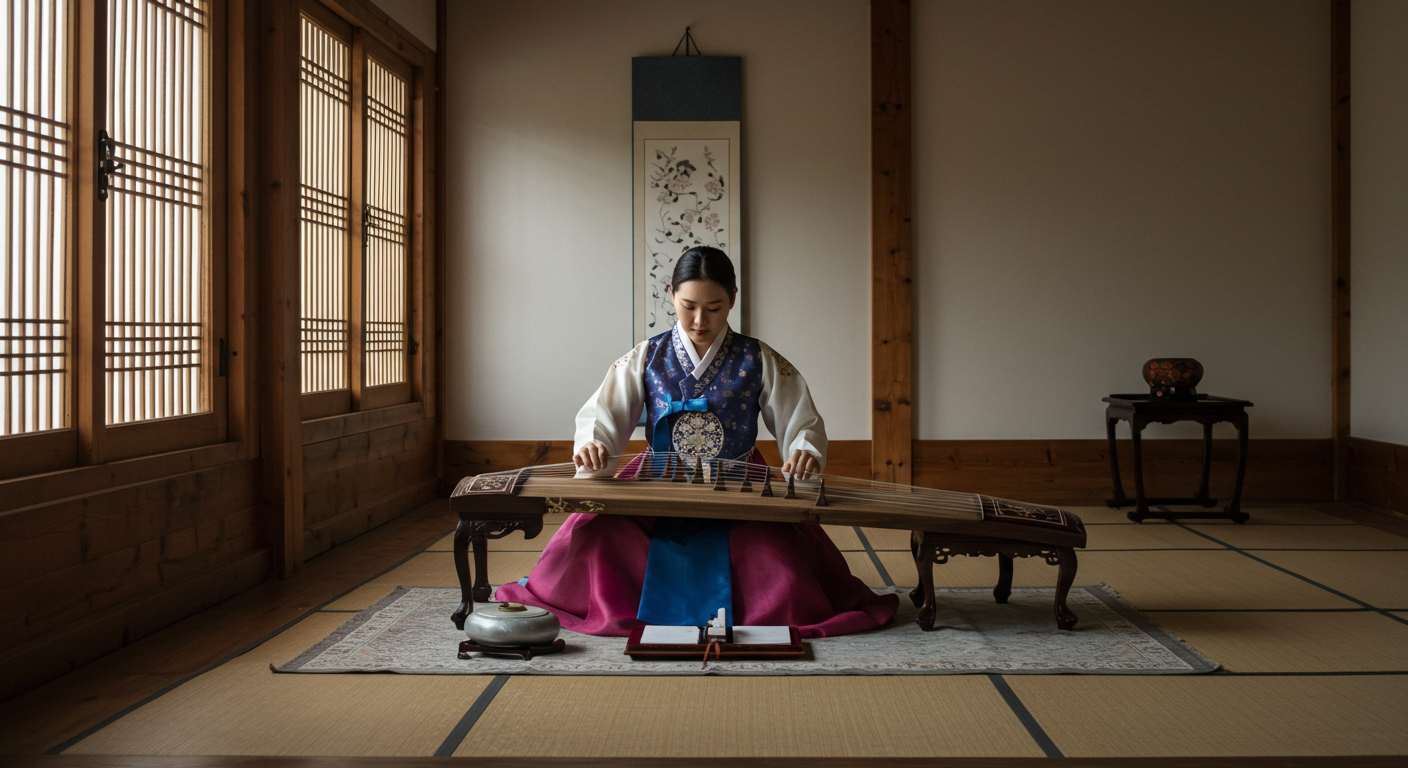-
contents
A String That Resonates Beyond Sound
The gayageum, with its graceful curves and delicate strings, is perhaps one of Korea’s most iconic traditional instruments. But what makes this zither-like creation unique is not just its sound—it’s the way it embraces silence. In a world filled with noise and stimulation, traditional Korean music cultivated a profound respect for quietness, pauses, and the space between notes. This reverence was not incidental; it was philosophical, rooted in centuries of Confucianism, Taoism, and indigenous aesthetics.
In this article, we explore how the gayageum became a symbol of sonic restraint, how Korean music's use of silence contrasts with Western traditions, and why these quiet spaces still matter in today’s fast-paced culture.
The Origins of the Gayageum: Strings of Serenity
The gayageum originated during the 6th century in the Gaya confederacy, from which it derives its name. King Gasil is said to have commissioned its creation after observing a Chinese zither. Yet, the Korean gayageum evolved in a distinct way: its tone was subtle, restrained, and earthy, reflecting the Korean peninsula's introspective spirit.
Crafted from paulownia wood and strung with silk or horsehair, the instrument produces a soft, mellow sound that rarely overwhelms. It was traditionally played in court music (jeongak) and solo performances (sanjo), emphasizing grace and precision over volume and speed.
More than a musical invention, the gayageum embodied a national character—quiet strength, emotional depth, and harmony with nature.
Silence as Structure: The Philosophy Behind the Pause
In Western music, silence is often used to create drama or transition. In Korean traditional music, particularly with the gayageum, silence is an active component of the melody itself. This aesthetic aligns with East Asian philosophies like Taoism, where emptiness and stillness are not voids but essential forms of existence.
The pauses between notes, called "yeojang" (여장), give the listener time to reflect. They invite internalization, creating a dialogue between sound and no-sound. Instead of filling every second, the gayageum trusts the listener to sit with ambiguity and introspection. This approach cultivates an atmosphere of emotional spaciousness that is rare in many musical traditions.
Even the tuning of the instrument emphasizes this principle. Musicians often slightly detune strings to introduce microtonal shifts, creating sonic environments where space, mood, and silence are just as audible as the notes themselves.
Cultural Contrasts: Silence in Korean vs. Western Music
Unlike Korean music, which embraces space and subtlety, Western classical music often prioritizes structure, climax, and continuous progression. While both traditions are rich and complex, the Korean approach encourages meditative listening, where silences carry as much narrative weight as the notes.
In gayageum performances, especially in solo formats like sanjo, the tempo changes organically. A listener is invited to join an emotional journey, not just a technical display. The tempo slows not because of exhaustion, but to linger in emotion.
These cultural differences reflect broader societal values. Western music mirrors societies focused on action and resolution; Korean music reflects a culture attuned to patience, nuance, and inner reflection.
The Role of Emotion: Han and the Unspoken
A recurring theme in Korean culture is "han" (한)—a deep, often indescribable feeling of grief, endurance, and longing. The gayageum, through its subtle vibrato and pregnant silences, is seen as an instrument that gives voice to han without uttering a word.
Performers manipulate tone with finger slides and plucks that echo the cadence of speech and sighs. Yet it's in the pauses that the emotion sinks in deepest. The music becomes less about expression and more about allowing emotion to exist without explanation.
This is why many listeners say that gayageum music makes them cry, even if they don’t know the story behind it. Silence gives room for personal interpretation, turning music into a mirror for the soul.
In sanjo performances, for instance, the tempo often speeds up toward a climax before falling silent again. These silences, placed between increasingly intense sequences, offer a release—a moment to exhale both physically and emotionally.
Gender and Grace: Feminine Energy in Gayageum Performance
Historically, the gayageum has been closely associated with female musicians. Court ladies, gisaeng (female entertainers), and modern female artists have carried its legacy, often combining performance with poetry, dance, or ritual.
The slow, careful movements required to play the gayageum mirror traditional ideals of feminine grace in Korean culture. But beyond gender, the instrument's style reflects yin energy—receptive, nurturing, and fluid.
In performances, it’s not uncommon for players to close their eyes, focusing not only on the sound they make but on the silence they leave behind. It becomes a kind of meditative performance, one where the player and listener are joined in stillness.
This meditative quality made the gayageum popular not only in court entertainment but also in shamanic rituals and private spiritual practices. The sound—and the silences—became channels for connecting with ancestors or divine spirits.

Echoes in Modern Art and Cinema
The influence of the gayageum and its philosophy of silence extends far beyond traditional music. In contemporary Korean cinema, directors like Lee Chang-dong and Kim Ki-duk use long, quiet takes to build emotional resonance. These cinematic silences draw inspiration from the same aesthetic principles that guide gayageum music: stillness, contemplation, and emotional honesty.
Even in modern art installations and sound-based media, Korean creators explore silence as a narrative tool. The gayageum is sometimes featured in minimalist compositions or fused with electronic music to amplify contrast between past and present, noise and quietude.
Modern Resonance: Silence in a Noisy World
Today, gayageum music is being revived in both traditional and contemporary forms. Artists like Hwang Byung-ki, Song So-hee, and modern crossover bands blend ancient styles with jazz, electronic, or ambient music. Yet, even in fusion, the principle of silence as substance remains.
In a world addicted to speed, stimulation, and multitasking, the gayageum's quiet philosophy offers a form of resistance. It reminds us that value doesn't always lie in what is said or played—but in what is withheld. The quiet spaces are not empty; they’re where the spirit breathes.
Some wellness and mindfulness communities in Korea now use gayageum performances as part of sound therapy or meditative practices, appreciating its slow rhythms and comforting silences as tools for healing and reflection.
Listening to the Silence
The gayageum teaches us that sound and silence are not opposites, but companions. In Korean music, silence is where emotion crystallizes, memory takes root, and spiritual depth emerges.
In a sense, silence becomes a gift—the invisible note that completes the song. The gayageum reminds us that listening is not a passive act; it’s a form of spiritual presence.
As you listen to a gayageum piece next time, pay attention not only to the notes, but to the air around them. The pauses are not mistakes; they are the music. And sometimes, they speak loudest of all.
'culture' 카테고리의 다른 글
K_Culture Guide
Korea Vibes Blog shares real stories, cultural insights, and travel tips from Korea. Discover what makes Korean life so unique.
